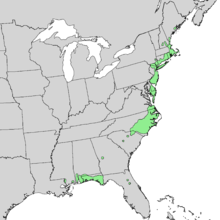Chamaecyparis thyoides
| Chamaecyparis thyoides | |
|---|---|
 |
|
| Chamaecyparis thyoides near the edge of a bog in New Jersey | |
| Scientific classification | |
| Kingdom: | Plantae |
| Division: | Pinophyta |
| Class: | Pinopsida |
| Order: | Pinales |
| Family: | Cupressaceae |
| Genus: | Chamaecyparis |
| Species: | C. thyoides |
| Binomial name | |
|
Chamaecyparis thyoides (L.) Britton, Sterns & Poggenb. |
|
 |
|
| Natural range of Chamaecyparis thyoides | |
Chamaecyparis thyoides (Atlantic white cedar, Atlantic white cypress, southern white cedar, whitecedar, or false-cypress), a species of Cupressaceae, is native to the Atlantic coast of North America and is found from southern Maine to Georgia and along the Gulf of Mexico coast from Florida to Mississippi. It is one of two species of Chamaecyparis found in North America. C. thyoides resides on the East Coast and C. lawsoniana can be found on the West Coast. There are two geographically isolated subspecies, treated by some botanists as distinct species, by others at just varietal rank: Chamaecyparis thyoides thyoides and Chamaecyparis thyoides henryae (H.L.Li) E.Murray (syn. Chamaecyparis thyoides subsp. henryae (H.L.Li) Little; Chamaecyparis henryae H.L.Li) The species grows in forested wetlands where they tend to dominate the canopy. The trees are associated with a wide variety of other wetland species because of their wide north-south range. The remaining populations are now found mostly in remote locations that would be difficult to harvest, so its popularity as a source of lumber has decreased.
Chamaecyparis thyoides grows within 20 and 100 m of the coastline and less than 50 m above sea level along much of the East Coast and Gulf Coast. Rare populations grow in the foothills of the Appalachian Mountains, where the tree may be found up to 460 m above sea level. Nationally, Atlantic white cedar are protected in the Great Dismal Swamp National Wildlife Refuge, Alligator River National Wildlife Refuge, Cape Cod National Seashore, Croatan National Forest, Francis Marion National Forest, Ocala National Forest, and Apalachicola National Forest. Altered fire regimes, logging, and draining of wetlands outside of the few protected areas have all contributed to the general decrease in the size and occurrences of Atlantic white cedar strands. The tree is listed as Rare in Georgia and New York, of Special Concern in Maine, and Extirpated in Pennsylvania.
...
Wikipedia

